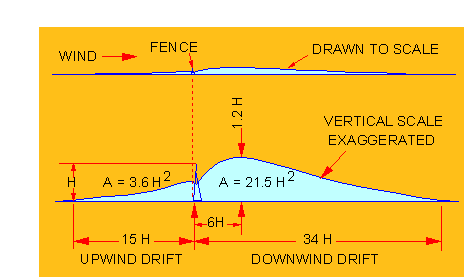
We use this equilibrium snowdrift cross section to compute how much snow transport the snow fence will trap. From the snow fences on I-80, we learned that the size and shape of equilibrium drifts scale with fence height H (Tabler 1980b, 1986). The maximum drift depth develops near 6H downwind and is about 1.2 times the fence height. The upwind drift develops slowly, until it extends to 15H and reaches maximum depth near 0.5H just upwind of the fence. One of the dimensions most surprising to us was how far the downwind drift extends. If the distance between the fence and road or other object is less than 34 times the fence height, then the equilibrium drift will reach the object. That can make a drift problem worse, instead of eliminating it.

In this photo, the drift downwind of a 12.4-ft Wyoming snow fence is near equilibrium (Tabler 1986). Wind is from the left.

 To Basics of Snowdrift Control
To Basics of Snowdrift Control